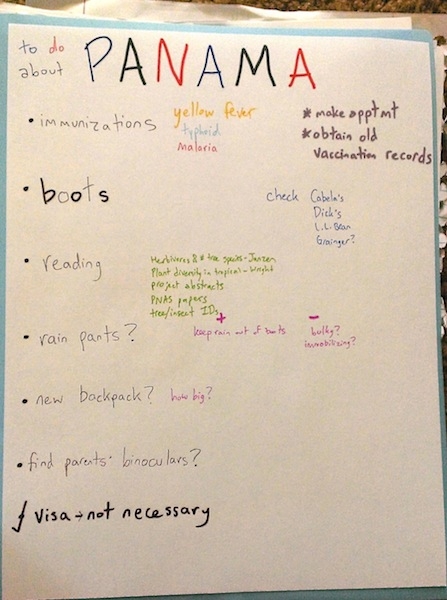Elizabeth gathers vital supplies for her tropical work placement.
I’m learning that field research in Panama is not going to be a walk in the park. It will be a hike through dense jungle—but I can take some measures to minimize discomfort and danger that I may face. According to my mentor, the following are of primary importance to prepare me for the summer ahead:
Immunizations: I thank the mosquitoes for this one. A vaccination is a must to protect me against the yellow fever, but I can take pills to steer clear of both typhoid and malaria because the immunization effects only need to last me for a few months. I can obtain these at a local travel clinic, but first, I must listen to a presentation that will inform me of current medical concerns that I should watch out for in Panama.
Rubber boots: Throughout most of the year (from May until December), the rainy season saturates Panama, so I will not miss the downpour during my 10-week excursion. Once the monsoons begin, humidity hangs in the air nearly all the time and moisture is unavoidable. I hope these boots will keep out the rain and be durable and comfortable as I hike around Barro Colorado Island, where our team will be collecting specimens and data. Beside the rain, the boots will also keep ticks and chiggers—and possibly snakes—from getting too close to my feet.
Journal articles: To familiarize myself with the research with which I will be helping, my mentors recommended I read several papers concerning other similar research projects, some of which were previously published by the scientists with whom I will be working. Plant Diversity in Tropical Forests by Dr. Joseph S. Wright is one example.
Trail gear: Though I do not plan on getting lost, a compass, flashlight and Ziploc bag to maintain a readable trail map could come in handy in the event of an emergency. I am spatially aware, but I should be proactive during the first weeks. A backpack will also be useful to carry these miscellaneous navigational tools and possibly trail mix too. We may be out there all day.
Rain gear and drifit shirts: When I sail, I wear a dry suit to keep the salty waves off my body and when I hike and collect specimens, I can wear rain pants to keep the downpour out of my trusty rubber boots, though I doubt my legs will be dry with the extreme humidity index.
Sweater: The residency I will occupy when I am not in the field will be an air-conditioned haven in the humidity. I will be at Gamboa, which is about a half hour north of Panama City and has laboratories, greenhouses and apartments for scientists on its campus. I envision a Jurassic Park-like compound—though Isla Nublar was in Costa Rica.
Binoculars (optional): The birds are supposed to be incredible and in no short supply.
